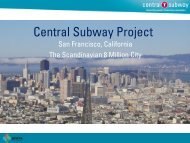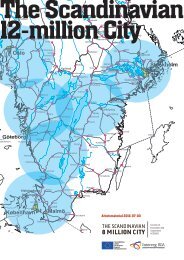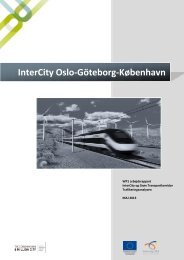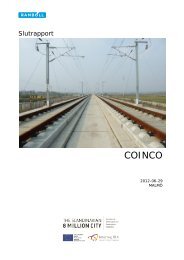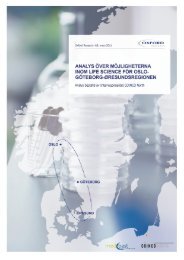Last ned The Scandinavian 12 million City - 8millioncity
Last ned The Scandinavian 12 million City - 8millioncity
Last ned The Scandinavian 12 million City - 8millioncity
- No tags were found...
Create successful ePaper yourself
Turn your PDF publications into a flip-book with our unique Google optimized e-Paper software.
<strong>The</strong> Procurement<strong>The</strong>re is real evidence thata well organised PPP approachdoes introduce thebest private sector skills– and can lead to the developmentof effective wholelife cost driven designand timely and on budgetconstruction. Traditionallyit has been difficult for thepublic sector to provide this.It can be seen from experience in Sweden and worldwide that a public/private partnership for theprocurement and operation of new infrastructure brings real benefits.However it has certainly also been seen that for such an approach to be successful, the public sectorcontribution has to be strong and effective. <strong>The</strong> process will flounder if clear leadership is not givenand, most damagingly, time tables are not observed and fundamental changes made. <strong>The</strong> commitmentof the private sector is substantial and this will only be made if there is fair certainty that theprocess will be completed.As was clearly seen with the Öresund project, political indecision can always exist, which can threatenthe project. However, again, as that project showed, a robust body acting as the grantor canensure that the project is driven forward.<strong>The</strong> Funding and FinancingWhile the exact mechanisms of funding and financing of these significant rail projects will varybetween different schemes, the fundamentals remain the same.Only in very rare circumstances will a HSR project generate adequate revenues from the firebox tocover not only the costs of operation of the train services and of the infrastructure but also the costsof building the system. Funding will be required to be made available from other sources.Further, although there have often been aspirations to bridge this gap through revenues generatedto the project developer through increase in the values of the land served by the new infrastructure,this target has proved elusive. While it is accepted that there will, over time, be a substantial upliftin the surrounding properties, only in very few occasions (eg Hong Kong metro development) hasit been possible for the developer to capture these gains adequately for himself to serve in the fundingof the project.In this context, therefore, it seems clear that the public sector will, almost inevitably, be involved inproviding subsidy to the project.<strong>The</strong> challenge then is to see how much can be generated from the project directly and how effectivelycan this be leveraged by the private developer and how this can be used to minimise additionalcosts to government.It is beyond this chapter to explore the different mechanisms that might be adopted by the privatesector to generate more funds itself for the purpose of the scheme – though one might note the approachesadopted especially in the US and increasingly in the UK where government recognises thelocal tax benefits that the project will bring – and directs these new incomes to the project. A veryrecent example of this is in London, where the underground rail service now under construction(Crossrail) will be funded in part through bonds raised against a revenue stream generated througha new special business rate charged on those likely to benefit from the new system. This one mightconsider an important tool in the context of COINCO.Further, recognizing that the new infrastructure will allow savings in the operating costs and maintenancecosts of existing (competing) infrastructure, insofar as these costs were to be borne by thepublic sector (eg in road maintenance) then this stream too might be allocated to COINCO. Thismight also include the second order effect of the transfer of freight from road to the present railnetworks – freed up to provide sufficient capacity because of the transfer of passenger services tothe new HSR.<strong>The</strong> discussion above has shown how, with the separation of infrastructure from services it allowsthe infrastructure provider to recognize a revenue stream – received as a path access charge from thetrain service operator. Insofar as this revenue can be recognized as a stable source of income to theinfrastructure provider, it is on the basis of this revenue that significant private funds can be raisedfor the development of the new project.This separation – and then the contracted payment by the train service operator for the use of theinfrastructure – underlies both the French Tours - Bordeaux project and the UK HS1. It is, ofcourse, analogous to the toll revenues and rail access charges generated on the Öresund Crossing;as with that project, these revenue streams can form the basis of the private involvement in thefinancing of the project.41



